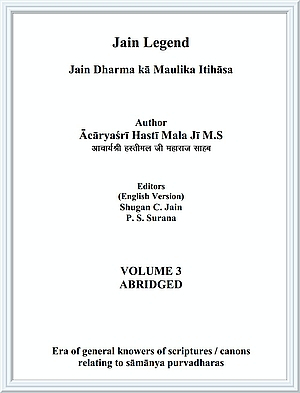28th Pontiff Ācāryaśrī Vīra Bhadra
| Birth | V.N. 959 | Special note: He was installed as the successor to the 27th pontiff of Lord Mahāvīra's congregation, the last of knower of prior canons Ācārya Devardhigaṇi Kṣamāśramaṇa. No details about his unique contributions to Jain congregation are traceable in Jain literature. |
| Initiation in monkhood | V.N.986 | |
| Attain Ācārya status | V.N. 1009 | |
| Left for heaven (Death) | V.N.1064 | |
| Period of householder life | 27years | |
| Period of ordinary monk | 23 years | |
| Period of Ācārya status | 55 years | |
| Complete monkhood | 78 years | |
| Life span | 105 years |
29th epochal-ācāryaśrī Hārila Sūri
| Other names | Hari Bhadra SūriI | Harigupta Sūri |
| 1st alternative | 2nd alternative | |
| Birth | V.N.943 | V.N.953 |
| Initiation in monkhood | V.N.960 | V.N.970 |
| Ordinary monkhood | V.N.960-1001 | V.N.970-1001 |
| Epochal ācārya period | V.N.1001-1055 | V.N.1001-1055 |
| Left for heavenly abode | V.N.1055 | V.N.1055 |
| Lifespan | 112 years 5months 5 days |
Considering the birth, initiation and life span of earlier prior-canons knowing epochal- ācāryas, the first alternative seems more tenable.
He was the contemporary of 28th pontiff Ācārya Vīra Bhadra. After Ācārya Devardhigaṇi Kṣamāśramaṇa, he was the next distinguished scholar ācārya with outstanding intellect of his time.
During the period when the foreign invaders started polluting and destroying the political environment in the country; common men and women were being tortured. The country was passing through a political turmoil. At that time Ācārya Hārila Bhadra, like an apostle with unlimited patience and outstanding intellect opposed these adversities in a nonviolent manner. He acted like a powerful preacher to bring comfort to suffering people who were being tortured under the cover of humanity. Greatly inspired by the sermons of this uncommon, spiritual and with divine aura Ācārya Hārila Bhadra, the deadly goon Hūṇa Rāja Toramāṇa became his disciple and started venerating him. By converting the dangerous and vastly inhuman Toramāṇa to his congregation, fame and popularity of epochal-ācārya Hārila spread far and wide. This incidence had been mentioned as an admirable reference by Udyotana Sūri (6th in the chronology of Hārila's successors) in 'Kuvalayamālā' composed in Śaka 7th century. This mention establishes the fact that epochal-ācārya Hārila Bhadra during his time relieved common people from the destructive acts of terrorist Toramāṇa and his large army.
In Jain literature we find three names used for Ācārya Hārila, namely;
- Hārila
- Harigupta
- Hari Bhadra
This Hari Bhadra is different from Viddyādhara branch Ācārya Yākinī Mahattarā sūnuh bhava Viraha Hari Bhadra Sūri who lived during V.N.1227-1297 and who reformed and rewrote Mahā Niśītha in V.N. 1255.
Probably after the death of Ācārya Hārila Bhadra, a separate gaccha was also established after his name. At that time, it was a usual practice to establish such a gaccha to pay reverence to an important ācārya who was a renowned scholar of high standard, popular and had special aura as well. Creating a separate gaccha under his name signifies that Ācārya Hārila had supreme knowledge of scriptures, was highly influential and was a capable epochal-ācārya as well.
 Acharya Hasti Mala
Acharya Hasti Mala
